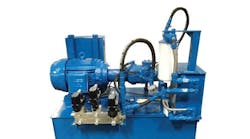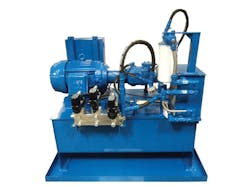The system pressure was set to 2250 psig with an output flow of 75 gpm. The pump would run for 30 to 60 seconds at a time under pressure, but then all pressure would quickly drop to near 0 psig for 2 to 3 seconds. Pressure would then quickly jump back up to 2250 psig. This happened 15 to 20 times before the test mechanic called me for help.
The unit piping had about ½-in. NPT and ½-in. O-ring connections. No Teflon tape was used, just white, paste-type pipe dope for sealing the NPT connections. We felt the only valve that could cause the malfunction was the pilot-operated relief, so we dis-assembled and inspected it. We did this at least four or five times and could not see any contamination or sticking problem.
We were pressed to move onto other units on the test stand, so we drained the oil from the reservoir and removed its access panels, with the eventual plan of retesting it later. However, we noticed that the reservoir bottom was covered with typical construction debris and a rather large amount of small beads of excess pipe dope.
Any idea what was causing the problem?
This file type includes high resolution graphics and schematics when applicable.
Solution to last month’s problem: Hydraulic system causes structural failure
The circuit design was intended to have the same speed lifting and lowering. The designer used a pressure and temperature-compensated flow control with 4-check valves arranged similar to an electrical “Diode bridge.” This always directed the oil flow coming from either direction through the flow control’s entry port. One of the checks failed open due to a contamination problem and allowed the oil to bypass the flow control and consequenty drop 60,000 pounds of steel coil 18” to a sudden stop.




